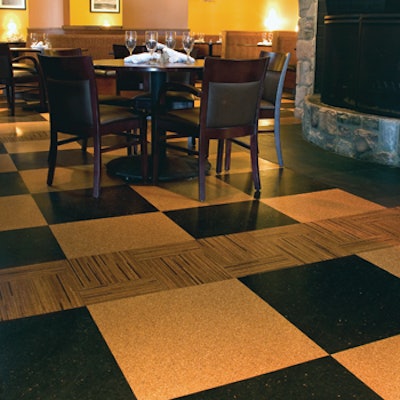
Cork flooring has been around for many years, but it's seeing a resurgence due to its unique aesthetics and unparalled green story. Keep these 10 facts in mind if you're working with cork for the first time.
1) Cork is not a structural product. If you're installing 3/16- or 5/16-inch cork tiles or planks, the structure needs to come from the substrate. If it's plywood, you'll need at least 1 inch of plywood down before installing the cork. Directly adhering to concrete slabs and/or Portland-based level compounds is the most common method for commercial (and some residential) applications.
2) Inconsistencies in the substrate translate to the surface. Installing cork is like installing resilient flooring-the substrate needs to be free of any imperfections or they will show in the floor's surface. If the subfloor is plywood, it must be underlayment-grade plywood and it cannot have any voids. Lots of people try to use luan, but luan can dent easily, which will transfer to the cork's surface. OSB and particleboard also are not acceptable. It is important to follow manufacturers' requirements; if you deviate from recommended substrates, you void the warranty.
 Mediterra Cork from Capri Cork
Mediterra Cork from Capri Cork
3) The subfloor can never be too clean. Those who are used to installing hardwood floors should think about getting the subfloor as clean as they would want to get a wood floor before they put on their last finish coat. A good rule of thumb is, "The substrate can't be too smooth, too flat or too clean." Imperfections might not show up immediately, but once the light changes or the floor is exposed to normal traffic, they may appear.
4) You must follow the instructions for the adhesive. Most cork manufacturers only recommend a low- or zero-VOC contact adhesive. This adhesive is applied to both the back of the tile and the substrate. When these two adhesive films make "contact" with each other, they create a very strong bond. When putting the tiles in place, the adhesive will grab, so be careful to put it down exactly where you want it to go-you will not be able to push or slide a tile into place. Once placed, use a soft-faced rubber mallet to hit the entire tile surface to ensure the two films become one.
5) Know if it's homogeneous or veneer cork. Know what construction you have before you do any abrading or finishing. Homogeneous (where the color/pattern goes through the product) is preferred for medium to heavy commercial installations, as it can be sanded. Veneer cork patterns can be screened but cannot be sanded. It is important to maintain the finish coats on both homogeneous and veneer cork.
6) Don't be too aggressive when sanding. Lots of people use multi-head sanders to resand a cork floor, and they work well. You can also use a big machine, but you need soft drum tension and nothing coarser than a 120 belt. If you're sanding a newly installed unfinished cork floor, you can just use a buffer and a 120 or 150 screen.
7) Many finishes work, but check with the cork manufacturer. Every cork manufacturer has specific recommendations for approved finishes on their cork. While it is possible that finishes other than their approved finish may work, the manufacturer will not support a warranty with an unapproved finish. Recommended finishes are primarily water-based urethanes; however, wax and natural oil systems are also sometimes used.
8) Maintenance is the same. You should maintain a cork floor exactly like you would a wood floor. If you wouldn't do it on wood, don't do it on cork.
9) Go vertical. These products are also popular for walls. The installation is the same-with contact adhesive rolled on. Many times wall installations use a wax finish.
10) When in doubt, call the manufacturer first. Manufacturers welcome phone calls for clarification of instructions and procedures prior to installations, not after.
































